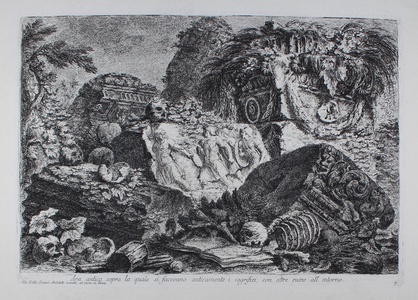| Method | Etching |
| Artist | Giovanni Battista Piranesi |
| Published | Gio. Batta. Piranesi Architetto invento, ed incise in Roma [Bouchard, c.1750] |
| Dimensions | Image 235 x 340 mm, Plate 242 x 345 mm, Sheet 382 x 540 mm |
| Notes |
One of Piranesi's earliest etchings, from a series of architectural caprices that were initially issued in his first published work, Prima Parte di Architetture, e Prospettive inventate, ed incise da Gio. Batta Piranesi Architetto Veneziano dedicate al Sig. Nicola Giobbe. The book was intended by Piranesi to challenge what he perceived as the languid nature of contemporary Roman architecture when compared to the grandeur of the antique past. The plates owe much to Baroque theatre design as well as the many capricci painted by his near contemporaries, but already display Piranesi's deep understanding and appreciation of classical forms and the romantic effect of time on antique stone. The book as published in 1743 contained 12 plates, and was evidently not successful, as there were no further parts despite the title's suggestion of further additions. In 1750, the plates, along with a set of five others engraved in the intervening years, were published in Bouchard's Opere Varie, along with some grotesques, a further two capricci, and the plates of the Carceri d'invenzione. The current example depicts a romantic jumble of architectural elements, including an ancient altar, though the majority of the scene is occupied by fragmentary examples of the many funerary monuments found in areas like the Via Appia on the outskirts of the ancient capital. The scene is strewn with human bones, and the artist's equipment, including an open sketchbook, can be seen in the foreground. Stylistically, the plate belongs to the suite of twelve original plates issued in the Prima Parte, though in subsequent printings of the Opere Varie was often moved down the order of plates, possibly because its subject matter was more fitted to Piranesi's other sepulchral illustrations and the following set of Grotteschi. Giovanni Battista (also Giambattista) Piranesi (1720 – 1778) was an Italian artist famous for his etchings of Rome and of fictitious and atmospheric "prisons" (the Carceri d'Invenzione). He was a major Italian printmaker, architect and antiquarian. The son of a Venetian master builder, he studied architecture and stage design, through which he became familiar with Illusionism. During the 1740's, when Rome was emerging as the centre of Neoclassicism, Piranesi began his lifelong obsession with the city's architecture. He was taught to etch by Giuseppe Vasi and this became the medium for which he was best known. Wilton Ely 19, F16, C335a, R18 (II) Condition: Strong clean impression. Folds to left and right edges of sheet, not affecting image or plate. |
| Framing | mounted |
| Price | £800.00 |
| Stock ID | 51348 |

